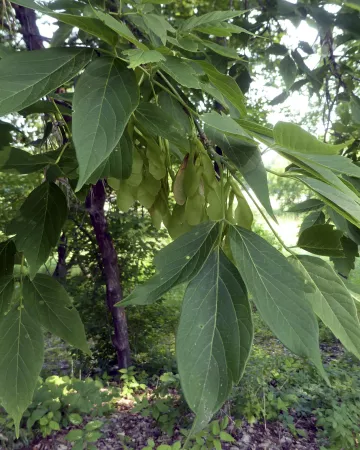
Photo Credit - Bob Suchanek
Bob Suchanek, Water and Wetlands Steward
Our daily walk around the lake brought forth a little flying friend to catch a ride on my wife’s shirt. The half inch long hitchhiker was a boxelder bug. No big deal for my unimpressed wife but the boxelder bug has a strong connection to the boxelder tree, the most important tree of my youth.
It's impossible for me to think unkind thoughts about this long-ago tree pal. I suppose I loved her for her “weediness” (climbability), “dirtiness” (sticks), “helicopters” (samaras or winged fruits), and “bugs” (friendly and cute). I didn't have a clue what “boxelder” meant and didn't care.
The boxelder tree in our back yard drew me, my sister and our friends every day; an accessible playhouse or a general merchandise store specializing in helicopter twirls and sticks with plenty of green leaves for cash. Everything that made her “weedy” made her wonderful to a kid.
Boxelders are generally considered a “weedy” tree and are held in pretty low regard by most people.
- Caitlin Reinartz, Wisconsin Urban Ecology Forester
A Tree of Many Names
The boxelder tree is native in the Western Hemisphere with varieties found from Canada to Central America. Linnaeus named this tree Acer negundo in 1753, a name that incorporates the maple tree genus Acer and the Sanskrit name nigrundi for “that which protects the body from diseases”.
According to the Ethnobotany of the Ojibwe Indians it had been used by them medicinally. Early European colonists thought it looked similar to elder trees in England and its wood like the old-world box shrub. There are many more common names but the best descriptive name in my opinion is “ash-leaved maple” because its leaves remind me of the ash tree. Its maple credentials include being tapped for syrup making in the spring. The boxelder's winged fruit (a samara) rotates as it falls to the ground, the tree helicopters of my youth.

Photo Credit - Bob Suchanek
The Bug
The entomologist Thomas Say (aka “The father of American Entomology”), who named the bug noted its affinity for wood (bois, French for “wood”) and the three striking red lines on the sides and center of its upper back (trivittata, Latin for “having three bands”). These insects are “true bugs” that feed on plants using their piercing-sucking mouth parts to extract nutritious juices. Their menu includes boxelder seeds and developing leaves as well as the juicy fruits of other plants.
Boxelder bugs develop through three life stages—egg, nymph, and adult. Red oval shaped eggs are laid on a host tree in the spring and nymphs emerge in about two weeks. The nymphs, small wingless versions of the adults, will shed their skins 5 times during the 7 or more weeks that it takes to grow into adults.
Humans and insects are competitors and sometimes boxelder bugs find our food and living spaces attractive. I don't recall having any gardening issues with boxelder bugs but maybe we were just lucky. My favorite boxelder tree didn't seem to mind playing bug host, however, I do remember these bugs in our basement, as they look for nice warm places to hibernate in the winter.
Sources
https://blogs.nwic.edu/briansblog/files/2013/02/Ethnobotany-of-the-Ojibwe-Indians.pdf
https://prairieecologist.com/2018/03/27/boxelder-bugs-accessible-ambassadors-for-nature/